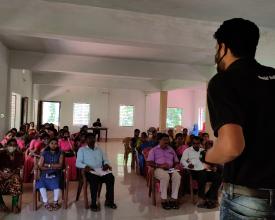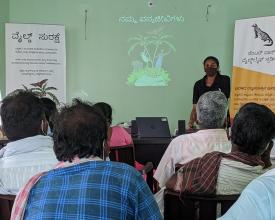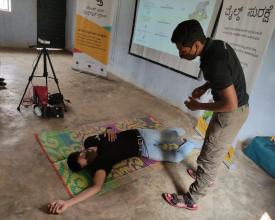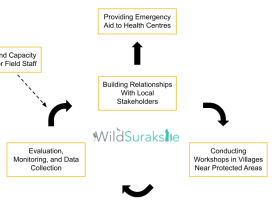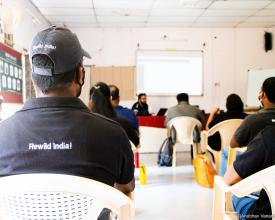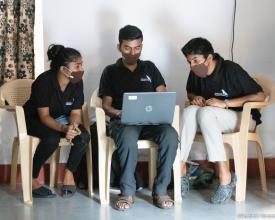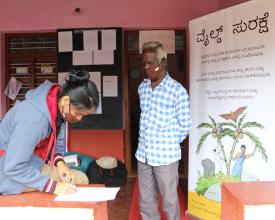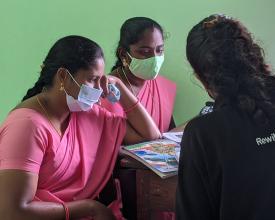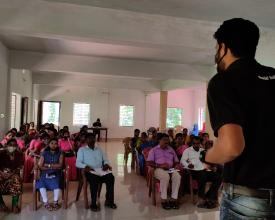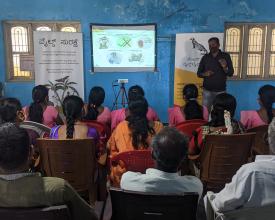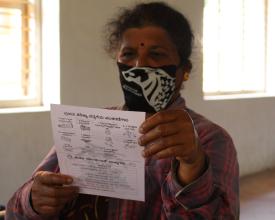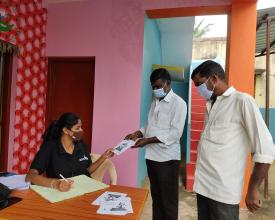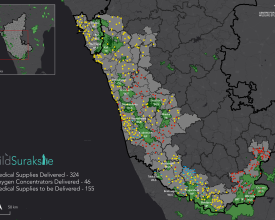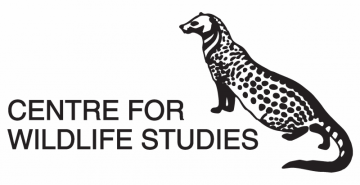
Wild Surakshe - A Public Health and Safety Program for Communities Living In and Around Protected Areas in the Western Ghats
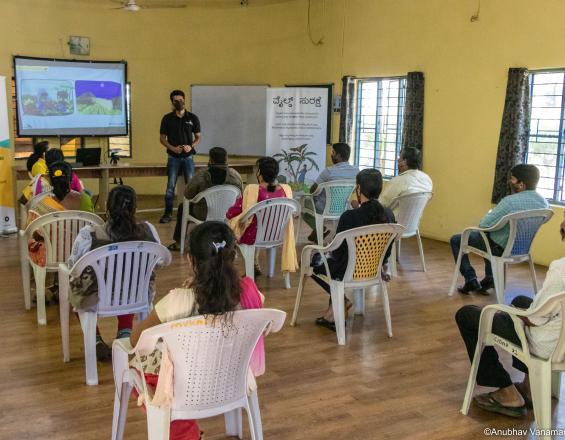
India's remaining wilderness consists of a highly disjointed network of protected areas interspersed with densely populated human settlements and domestic animals. This close proximity of people and wildlife leads to high rates of human-wildlife conflict and an increased probability of zoonotic disease transmission between people, livestock, and wild animals. Wild Surakshe is a large-scale outreach and education program targeting communities close to protected areas in the Western Ghats. It involves conducting training and awareness workshops focused on the prevention of zoonotic disease outbreaks, prevention of dangerous encounters with wild animals such as elephants, tigers, and snakes, and effective response to human-wildlife conflict. The workshops also provide basic first aid training and information about emergency service providers. Besides local communities, the workshops engage frontline representatives from village panchayats, forest and health departments, veterinary centres, and community-led cooperatives.
Context
Challenges addressed
Since almost four decades of conservation practice, we have focused on improving the lives, livelihoods and well-being of communities living on the fringes of PAs. These communities face significant economic losses due to high levels of human-wildlife conflict including crop loss, livestock depredation, and injury or loss of human life. Due to their proximity to the wilderness, they are also extremely vulnerable to zoonotic diseases, which can emerge from wild animal reservoirs. Repeated instances of conflict and disease and limited access to health care have eroded trust in government agencies, giving rise to negative attitudes towards PAs and retaliation against wild animals and government staff. Given this context in rural India, there is an urgent need to address poor knowledge, lack of awareness, and the scarcity of health resources. Our program uses interactive workshops to improve people’s knowledge and awareness and build trust between various stakeholders.
Location
Process
Summary of the process
Through Wild Surakshe we hire and train field staff, build relationships with local stakeholders, conduct workshops in rural villages, evaluate the program and collect data on disease outbreaks, and provide immediate emergency relief to primary health centres. Our trained field staff interact with stakeholders before workshops and recruit participants. They decide where the workshop will be held and obtain the necessary permissions. On the day of the workshop, they take participants through each of the 5 sessions with videos, demonstrations and distributed guidelines. Once the workshop is completed, they contact participants to obtain feedback and enter information about the workshop into our app, Wild Connect. This cycle of stakeholder interaction, workshops, and data collection is at the core of the Wild Surakshe program. Staff are hired and trained periodically, which facilitates this cycle. Immediate relief to health centres is only done in emergency situations such as the ongoing pandemic, and it helps us strengthen our relationships with communities and frontline workers, thus helping us pave the way for future support and increased impact.
Building Blocks
Capacity Building for Field Staff
For program implementation, we recruit field staff who conduct the workshops, deliver the content to participants, and collect evaluation data. Each team works in a specific region of the Western Ghats. We select people who are local to the area and can speak in multiple languages such as Hindi, Kannada, Konkani, Tamil, and Malayalam. Once staff are hired, we teach them to disseminate the workshop content and ensure they understand the intended impact of each session. We train them in first aid using demonstrations and real-life examples. We also teach them best practices for community engagement and ethics. So far we have trained 1 Program Manager, 6 Project Coordinators, and 13 Educators for Wild Surakshe. Having well-trained, passionate, and dedicated field staff has been instrumental in allowing us to cover 11 PAs. Wild Connect, our app for offline data collection, has also helped us streamline data management making it easier to manage the program. These factors will be key for scaling to 69 PAs over the next 3-5 years. Currently, our teams conduct the workshops in local languages (eg. Kannada) but enter data on the app in English. We plan to incorporate multilingual services on our app.
Enabling factors
1. We choose field staff based on past experience, enthusiasm, educational background, community engagement skills, and the ability to work with government staff.
2. We teach staff public speaking skills and go over the delivery of each session multiple times. Emphasis is placed on learning how to capture the attention of large audiences and make concepts easy to understand.
3. We ensure that staff members are trained based on established research and guidelines by experts.
4. We train field staff at frequent intervals and provide continuous feedback.
Lesson learned
1. The field staff need to be trained not just on workshop delivery, but also on how to interact with government officials and community members.
2. Previous experience with community engagement and public speaking should be taken into consideration while hiring educators.
Building Relationships With Local Stakeholders
Before conducting workshops, we build connections with local key stakeholders who are at the frontline of managing zoonotics and human-wildlife conflict. First, we contact the state health ministries. Currently, we have support from the Directorate of Health Services in Goa and the Department of Health and Family Welfare in Karnataka. We then identify districts for conducting workshops and obtain permissions from the District Commissioner, District Zilla Panchayat CEO, District Health Officer, and Forest Department officials. So far, we have done this in 10 districts. We also meet and get permissions from taluk (sub-district) officers including Taluk Executive Officers of Panchayats, and Block Medical Officers. Next, we identify the Village Gram Panchayats where we will conduct workshops and get permissions from Panchayat Development Officers and Primary Healthcare Centers. Lastly, we visit and invite local prominent citizens or organizations relevant to our program such as previous partners, teachers, child development program officials, veterinary officials, and farmer cooperatives. We use these interactions to understand local health and infrastructure challenges. Based on our findings and the local ecological and socioeconomic context, we adapt the content of our workshops.
Enabling factors
1. We take local socio-economic and ecological conditions into consideration.
2. We take notes on local cultural perspectives towards wildlife.
3. We obtain information on local health conditions such as accessibility to healthcare, interest levels in visiting primary health centers, major deterrents to availing these facilities, prominent diseases which we should talk about, etc.
4. We analyze past disease outbreaks or human-wildlife conflict incidents from the village which can be used as examples.
Lesson learned
Some of the challenges that we faced while working with remote, rural communities were:
1. Mobilizing stakeholders to participate in our workshops due to the remoteness of locations and the COVID-19 pandemic
2. Scheduling workshops and coordinating with diverse groups of participants, their COVID-19 duties, local festivals and other events
3. Travel to and from the workshops for both staff and participants in remote areas with poor travel and communication infrastructure (such as lack of mobile phone connectivity)
We have now learned that while meeting with stakeholders and inviting participants it is essential to take everyone’s availability into account, consult as many people as possible about the date and time, and hold the workshop in an easily accessible and centralized place. During the course of project implementation, we have also developed several best practices for ensuring workshops are relevant to the local context. Different socio-cultural practices of local communities (some of them tribal) are taken into account while conducting workshops.
Conducting Workshops in Villages Near Protected Areas
Workshops are conducted in vulnerable villages focusing on public health and safety by trained CWS staff. Participants usually consist of families, frontline workers, government staff, and members of other non-profit and self-help groups. The workshops are conducted using illustrations, videos, and demonstrations. Each workshop has five sessions. The first session titled “ Our Wildlife'' introduces the participants to various wildlife species found in their landscape and their significance. The second session, “Preventing Injuries due to wildlife” teaches the participants how to coexist with wildlife and the do’s and don’ts of wildlife encounters. The third session titled “Responding to Wildlife Encounters” takes participants through the steps one can follow if a conflict incident such as livestock loss or injury takes place. The fourth session “Zoonotic Diseases'' shares important information on seven relevant zoonotic diseases - COVID-19, Nipah, Scrub Typhus, Kyasanur Forest Disease, etc. The fifth and final session “Basic First Aid'' teaches participants various basic first aid techniques through demonstrations. After each workshop, we also distribute safety guidelines and emergency contact information. To obtain feedback and evaluate effectiveness, we conduct pre and post surveys before and after each workshop.
Enabling factors
1. We ensure workshops are interactive with questions/ discussions/ local examples.
2. We encourage participation of representatives from all relevant sectors (health/forest/administration/self-help groups/panchayats etc.)
3. We use videos and demonstrations for better visualization of concepts.
4. While concluding workshops, we ask for feedback and try to apply it in following workshops.
5. We provide handouts with summarized information.
Lesson learned
After conducting several workshops we have learned the following:
1. Most of the participants are busy and travel from far locations. We ensure we know about time constraints at the start of each workshop so that participants can be present for the entire duration.
2. Breaks between sessions are important for participants to discuss and absorb information.
3. We encourage local leaders to help us identify the people we can invite, which enables better discussions during the workshop.
Evaluation, Monitoring and Data Collection
Before and after each Wild Surakshe workshop, we conduct pre and post surveys. The surveys allow us to record the baseline level of knowledge of participants and to receive feedback about the workshops. So far we have conducted more than 3000 pre surveys and 2500 post surveys. We are currently analyzing the information collected from these surveys from over 150 workshops.To enable offline data collection in remote areas we have developed an application and platform called Wild Connect. Our staff download the app on their phone to access the forms they need to fill. Once the data is entered, the forms are stored locally, then uploaded to the cloud whenever internet connectivity is available. This cloud data can be accessed and downloaded by our central office staff for validation and further analysis. Our staff also use the app to collect data on human-wildlife conflict incidents. Wild Connect is only used by CWS staff to collect data, and is not used for any insurance or compensation payments. The results and outputs from the Wild Surakshe program will be shared with relevant government and private agencies and published in peer-reviewed scientific articles and reports to develop targeted long-term interventions to prevent future outbreaks and the rapid spread of zoonotic diseases.
Enabling factors
1. We ensure field staff are well trained in unbiased and accurate data collection.
2. The pre and post surveys administered are well structured and detailed, which enables effective evaluation.
3. The participants are asked about the effectiveness of the program twice, at the end of the workshop and while conducting post surveys.
Lesson learned
1. Sometimes, using laptops or mobile phones to gather data makes some of the participants uneasy. Some of them are still skeptical about the use of technology.
2. When field staff conduct a workshop and contact participants post surveys over the telephone to seek suggestions, participants have been very welcoming and our relationship with the communities has grown stronger.
3. Currently, our app does not have multilingual services and support, but we plan on incorporating this in the future.
Providing Emergency Aid to Health Centres
The second wave of COVID-19 in April, 2021 left India in deep distress, with rural and remote communities affected severely. These areas have a huge shortage of essential supplies and medicines, with primary health centre (PHC) workers being short staffed and overworked. Due to CWS’ strong on-ground presence and the implementation of Wild Surakshe workshops in rural Karnataka and Goa, we were able to directly observe the devastating impacts of COVID-19 on people in rural India.
The Wild Surakshe program has enabled us to build a network of several hundred people to act on the ground. Thus, our local field staff are well-equipped to provide support and help curtail the rapid spread of COVID-19 and similar zoonotic diseases in these areas.
We are currently using our resources to support over 500 PHCs across Karnataka and Goa by procuring COVID-19 essentials like face shields, PPE kits, oximeters, thermal scanners, gloves, masks, and medicines. Our field staff are also closely monitoring the state of these PHCs to offer any additional immediate assistance they need. By providing such immediate assistance during emergencies in our project areas, we want to ensure people are getting help when they really need it, and strengthen our ties to local communities and stakeholders.
Enabling factors
1. We speak to medical staff and community workers to identify rural PHCs in remote areas without access to COVID-19 relief materials and take note of their patient loads and requirements.
2. We raise funding, source materials and provide medical resources requested by them such as oxygen concentrators, pulse oximeters, BP Monitors, IR thermometers, etc.
3. Our pre-existing relationships with PHCs through Wild Surakshe and other CWS programs help us understand local challenges and effectively meet their requirements.
Lesson learned
1. Communities in these remote areas were hit hard by the second wave of COVID-19 in India, and need urgent ongoing support and relief to manage this and future outbreaks.
2. Doctors from primary health centres in these areas have a very strong network. By tapping into this network and forging a long-term relationship with doctors, we can understand local conditions and health requirements better for future interventions and continued support.
Impacts
We have conducted 150 workshops and engaged over 4000 people around 11 PAs in rural Karnataka and Goa. CWS staff have conducted 735 sessions, investing over 800 hours of training. Participants of workshops have included representatives from the forest and health departments, NGOs and self-help groups, farmers, fishermen and small tradesmen. We have had members of government missions such as the National Rural Livelihood Mission, Child Development and Protection, and the Eco-Development Committee attend our workshops. So far, the response of participants has been extremely positive. To measure effectiveness, we have conducted over 3000 pre surveys and 2600 post surveys, which are currently being analysed. IN the next 3-5 years, we plan to reach all 69 PAs in the Western Ghats. Our desired long-term impacts are increased economic and social well-being for people living close to PAs and improved attitudes towards wildlife conservation. By empowering people to prevent conflict incidents, the program will help curb retaliation and mob violence against PAs, the government and wildlife. By highlighting medically sound prevention and treatment measures, our program will help reduce zoonotic disease transmission and outbreaks. We plan to share the outcomes of our program through scientific and popular articles, and open source materials and training for other wildlife and health organisations.
Beneficiaries
Our current and future beneficiaries are an estimated 50,000 people from communities near 69 PAs in the Western Ghats and frontline staff from panchayat, government, and non-profit groups. Most lie below 80% of India's income distribution.
Sustainable Development Goals
Story
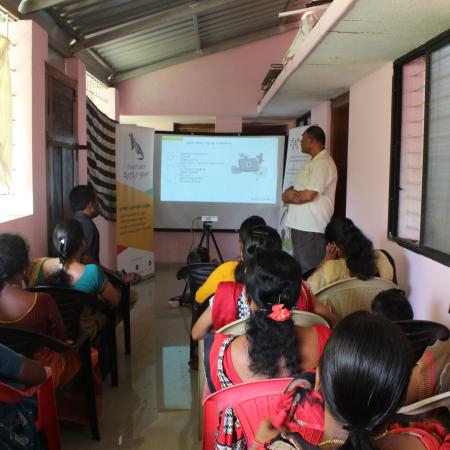
As a part of our evaluation, we conduct post surveys after each workshop to understand their effectiveness. In one such post survey call, we learned that one of our beneficiaries, Shyamala TC, was able to save a man’s life using Wild Surakshe safety techniques!
Just two days after attending a workshop in a village near Virajpet taluk in October, 2020, Shyamala’s neighbour was bitten by a Russell's Viper, one of the most venomous snakes found in India. It was Shyamala who immediately identified the venomous snake and suggested the right treatment, anti-venom, instead of blade cuts, tying a tourniquet, local rituals or herbal pastes. She even stopped the people who gathered from killing the snake. Elated, Shyamala credits the Wild Surakshe team for making her aware. She says programs like these should reach more vulnerable communities like hers.

